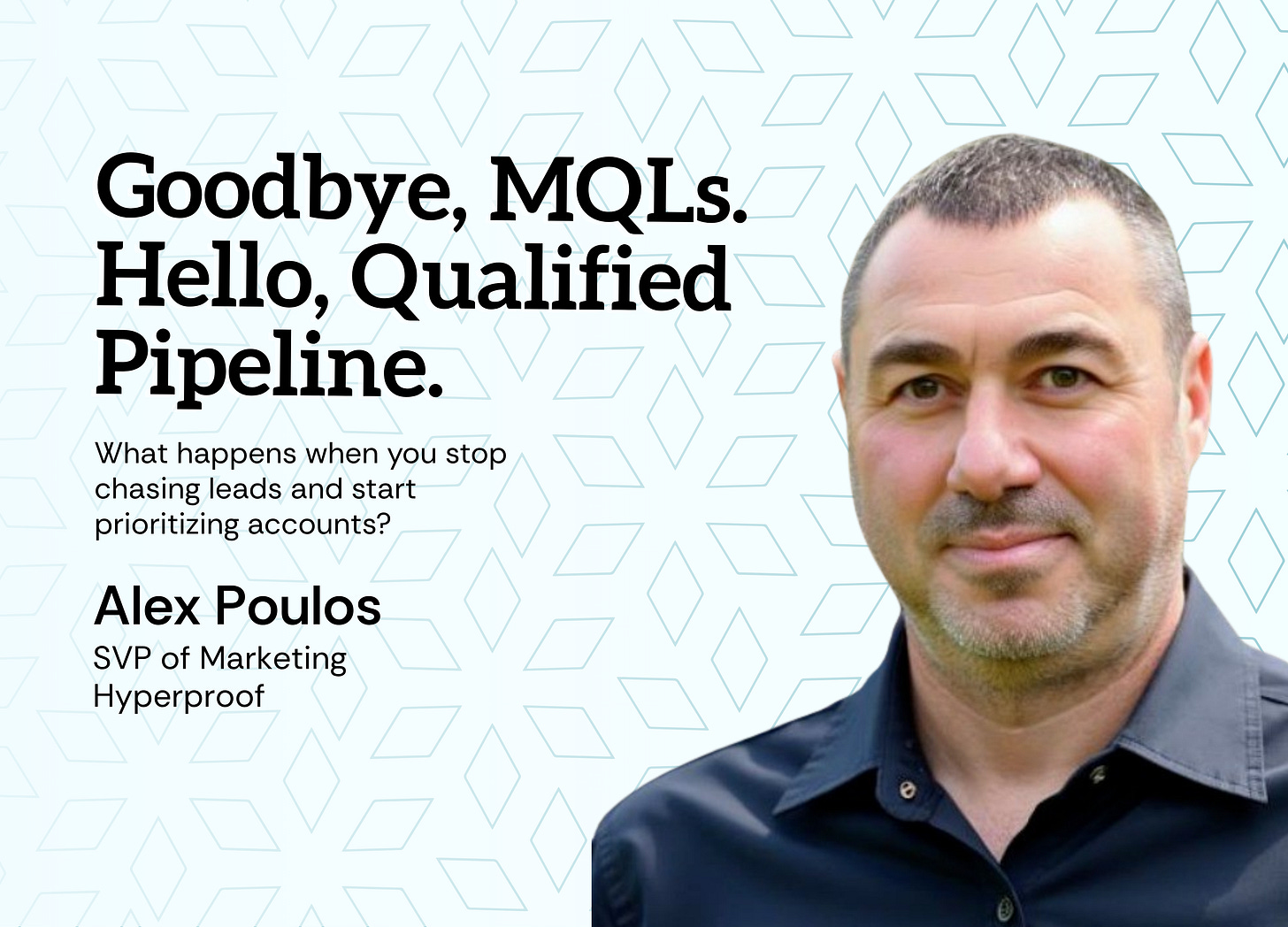Goodbye, MQLs. Hello, Qualified Pipeline.
What happens when you stop chasing leads and start prioritizing accounts?
DEAR STAGE 2: I’m the VP of Marketing at a Series A company. We’re selling to enterprise accounts in a fairly niche vertical and I’m making the argument that we should stop setting targets based on a “traditional” MQL funnel, and instead build out entire marketing and GTM strategy around a narrow set of ICP target accounts. Have others done this? Any advice?
~SHIFTING TO ACCOUNT-BASED GTM
DEAR SHIFTING TO ACCOUNT-BASED GTM: In the increasingly noisy world of lead gen, breaking through and getting a prospect’s attention is no easy feat which is leading to many more companies making the decision to pivot to an account-based GTM motion.
The evolution of the traditional MQL funnel is well underway and I wanted to hear a real-life example so I called on Alex Poulos, Stage 2 LP and SVP of Marketing at Hyperproof, who’s in the thick of shifting his company away from traditional MQLs and into a truly account-centric GTM model.
Make no mistake, this is a company-wide effort and transformation.
Here’s how Alex has approached the shift:
Top-Down Buy In and Commitment
This is not a change that marketing can drive alone and I’ve personally seen this transition go awry when a CEO sees lead numbers dropping, hears complaints from sales and pulls the plug 2 months in. When Alex and I discussed this scenario, he highlighted the need for the CEO (and probably the board) to be fully bought in. This means bringing data to the CEO to make the case that MQLs are not scaling fast enough to meet the plan, and getting commitment on an overarching GTM strategy change.
When you get the yes, the first step is unlearning the old metrics and replacing them with a new framework and goals. Alex called out the need to capitalize on momentum and deliver fast, visible wins. In his case this looked like:
A new dashboard with shared marketing/sales metrics for “qualified pipeline”
Clarity around ICP criteria and a revised BANT-style qualification for pipeline
A quick-turn ABM campaign initiative to show immediate progress and wins (more on this below)
Redesign/Realign Your Org
In this new account-based model, Alex defined the critical North Star KPI for the GTM org as ‘qualified pipeline’. Not lead volume. Not MQLs. To make that work, Alex had to rethink the structure of his marketing team. A few changes he’s made that you might consider:
Unify the demand gen team. Alex hired a new Head of ABM to oversee field, digital, and partner marketing as well as the BDR function.
Move BDRs under marketing for tighter coordination and aligned with AEs over joint books of accounts.
Rewrite job descriptions across the team to align to the new motion. Each member of the team should take the lead on his/her own role with input and feedback from leadership.
Drive Cross-Functional Alignment
One of the smartest moves Alex made? He launched a weekly meeting with leaders from sales, customer success, RevOps, finance, and marketing. You might feel resistance here at first (“can’t marketing just take care of this?”), but by bringing in leaders across the business you make it clear that this an org wide effort that impacts the entire company.
For the first meeting, Alex asked each departmental representative to come prepared with one thing: what concerns do you have? This conversation led to a list of action items that spurned everyone into action.
“It will take 4 weeks to train on the team on X” → Agreed! Sales Enablement has a project. Go.
“Our salesforce account view is not set up to handle Y” → Correct. Rev Ops has a project. Go.
Once everyone is in motion and working towards the same goals the standing meeting agenda can morph. A few ideas for topics:
Align on top target accounts for the period
Review current campaigns and results
Adjust campaign timing based on readiness
Resolve cross-functional blockers
Start Campaigns Early (Even Before You’re Fully Ready)
Alex’s advice: start running campaigns while you're still phasing out MQLs. Why?
It builds muscle memory
It shows progress
It surfaces gaps you’ll need to close before you scale
Starting small is an opportunity. Anyone in the company can suggest a campaign and can see both the effort and impact. Critically, these campaigns have to have clear start and end dates, target a specific list, and be evaluated on pipeline impact (the long term metric we now care about!).
Yes, these first efforts are scrappy and manual. But they help the company get comfortable with a new way of thinking and build confidence that this isn’t just a marketing experiment and is actually the new GTM model.
ABM at Scale
Most companies should start with a small number of high value accounts, but as you scale up, Alex recommends building a tiered model:
Enterprise or Tier 1 Accounts → 1:1 with bespoke touches
Mid-market or Tier 2 Accounts → 1:few segmentation and campaigns
Velocity accounts or broader SAM → 1:many playbooks
Every quarter, accounts are retired and refreshed based on progress. The marketing team owns that process, with feedback loops to engage sales, CS, and product teams.
Ultimately, you’ll have to prove this model out while you build it. This kind of transformation requires leadership, process, and real deliverables. You need to set a standard and show the company what good looks like before the results fully materialize.
And when you do? Suddenly, the whole company is speaking the same language—and you’ve got the foundation for a much more durable go-to-market engine.
Until next week!



